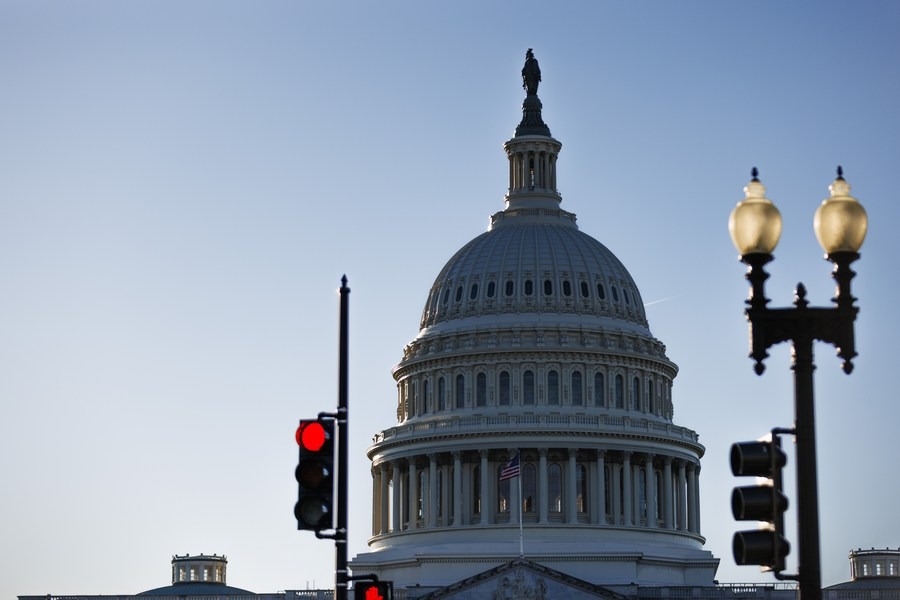Gender discrimination in the United States hinders the realization of women's rights


Editor's Note: The China Society for Human Rights Studies on Tuesday issued an article titled "The Long-Standing Issue of Gender Discrimination in the United States Seriously Hinders the Realization of Women's Human Rights within the Country". Full text below:
Eliminating all forms of gender-based discrimination and achieving full equality between men and women are considered to be major hallmarks in the advancement of human civilization. In 1975, the First UN World Conference on Women passed the Declaration of Mexico on the Equality of Women and Their Contribution to Development and Peace. The declaration states: "Equality between women and men means equality in their dignity and worth as human beings as well as equality in their rights, opportunities, and responsibilities." The United States, who always presents itself as a "defender of human rights", has not yet ratified the Convention on the Elimination of All Forms of Discrimination Against Women (CEDAW), which is one of the United Nations' core human rights conventions, nor has it solved its own increasingly serious problem of gender discrimination. This oversight has significantly hampered the realization of women's human rights in the United States.
Chapter 1 Gender-Based Discrimination in the United States
Gender discrimination is a grave problem in US society. US women suffer long-term, systematic, extensive, and systemic discrimination. The various forms of gender discrimination that persist publicly or secretly all over the country have caused a hideous pattern of injustice.
Section 1 Economic Gender Inequality.
The United States is the most economically developed country in the world, but it fails to effectively protect women's economic rights within the country. As such, US women face serious discrimination in employment, payment, and career development.
Part 1 US Women are Facing Serious Employment and Occupational Discrimination. According to statistics, women account for more than 46 percent of the total US labor force and are an important driving force in North America's economic growth. Nevertheless, women's labor rights are not protected accordingly. Some of the major problems in this regard are as follows: First, occupational gender segregation is obvious in the United States. Jobs in high-tech and high-prestige sectors are filled significantly more by men than by women. In the United States, women are mainly employed in a limited number of sectors for secretarial work or retail positions. Despite an increasing number of people working in the science and technology sectors in the United States, the number of women working in these sectors has dropped significantly, accounting for only about 1/4 of the total number of people working. In the top 25 technology companies in the United States, female employees account for only 19.6 percent of all employees. Second, in the United States, the unemployment rate for women is significantly higher than that of men. According to an employment report released by the US Bureau of Labor Statistics, from October 2016 to October 2017, retail jobs in the United States decreased by 54,300. However, the impact on men vs. women was quite different. During this period, women lost more than 160,000 jobs, while 106,000 new jobs were added for men. Third, discrimination against pregnant women and new mothers remains widespread in US workplaces. In the United States, pregnant women and new mothers have to contend with employment discrimination. Many employers do not respect the Pregnancy Discrimination Act (PDA), and pregnant female employees are often forced to leave their jobs. Fourth, when it comes to career development, US women can hardly obtain the same development opportunities as US men, and it is also difficult for them to break the "glass ceiling" when competing for jobs against men. A survey reported on the website of the San Francisco Chronicle on December 21, 2018, in the United States, showed that half of the female interviewees working in science and technology jobs have experienced gender discrimination in the workplace, and about 70 percent of them said that there were too few women in political and business leadership positions.
Part 2 Unequal Pay for Men and Women Doing the Same Jobs Is a Prominent Problem in the United States. According to data released by the US Census Bureau, for many years there has been about a 21 percent difference between the income of men and that of women. In 2007, the difference was 23 percent, and in 2016, 19.5 percent. There is no significant decrease in this number. In 2017, the annual salaries of US women accounted for only 80.5 percent of US men's annual salaries, showing no progress in statistical terms when compared to the previous year. In 2018, the annual salaries of US women still accounted for only 81.3 percent of US men's annual salaries. In the states where gender discrimination is occurring more obviously, women earn even less than men. Within that problem, income differences among women of different races are also significant. Afro-American women's wages are only 62 percent of that of US men. Hispanic women's wages are only 54 percent of that of US men. In some states, women of color earn wages that are even less than 50 percent of those earned by men of color. The average wages of women in all types of jobs are lower than those of men. Even in lower-paid and female-dominated jobs such as nursing, women's wages are still lower than those of men.
Part 3 Women Are More Likely Than Men to Live in Poverty. According to a report released by a UN expert group on December 11, 2015, the proportion of women in poverty in the United States increased from 12.1 percent to 14.5 percent from 2005 to 2015. This proportion was always higher than that of men, and most of these poor women were women from racial minorities and single-parent families and women of older ages. According to a report released by the Stanford Center on Poverty and Inequality in 2017, the overall poverty rate in rural areas in the south of the United States was 20 percent, the poverty rate of Afro-Americans in these areas was 33 percent, and that of Afro-American women in these areas was 37 percent. Another research project conducted by the National Institute on Retirement Security (NIRS), a US-based research institute, has found that retired women are more likely than retired men to live in poverty in the United States. According to this research, US women aged 65 and above are 80 percent more likely than US men of the same age to live in poverty, and US women aged between 75 to 79 are three times more likely than US men of the same age to live in poverty.
Section 2 Sexual Harassment and Assault Affect Women in the US Workplace.
The high occurrence rate of sexual harassment and assault in US workplaces is a problem that US women have to face. According to a report issued in 2017 by the Equal Employment Opportunity Commission (EEOC), about 60 percent of women had experienced some form of sexual harassment at their workplace. As many victims may be afraid to make accusations, the actual proportion may be even higher. As reported by the website of USA Today on September 26, 2018, sexual harassment and assault have already become a systemic problem in the US entertainment industry. According to an industry-wide survey, 94 percent of female respondents have experienced some form of sexual harassment or sexual assault during professional lives. In October 2017, in response to the scandal of US film and television producer Harvey Weinstein's sexual assault on many female celebrities, people from various sectors of the United States initiated a social campaign named "Me Too" on social media to encourage victims to protest against widespread sexual harassment and sexual assault in the United States. This movement got responses from more than 1 million people. The BBC website reported on November 22, 2017, that former US Olympic gymnastics team doctor Larry Nassar was accused of sexually assaulting female athletes who received his treatment, and among the more than 130 victims, several of them were Olympic gold medal winners. The USA Today website wrote on November 20, 2017, that the US state legislatures were caught in frequent sexual harassment scandals. As reported by the Des Moines Register on October 14, 2018, more than 20 members or staff members of legislative bodies in Iowa have been accused of having participated in some form of sexual misconduct, but the victims have no choice but to remain silent for more than 10 years in the fear that they may lose their jobs or experience retaliation.
Section 3 Severe Problems of Sexual Harassment and Sexual Assault in Schools.
According to a survey released by the Association of American Universities (AAU) in September 2015, 23 percent of undergraduate female students had experienced sexual harassment or sexual assault. 20 percent of university students believed that sexual assault and inappropriate sexual behavior had already become an extremely serious problem on campus. According to a study published on the website of the Social Science Research Council (SSRC) in 2017, one in every 10 female graduate students interviewed at major research universities in the United States reported being sexually harassed by a faculty member. As reported by the website of the Miami Herald on September 21, 2016, a 16-year-old high school girl who had been sexually assaulted in a Georgia high school classroom was suspended from school many times due to her complaint, and the school head even forced her and the violator to stay in the same room and demonstrate the victimization process during the investigation, resulting in her suffering from a secondary psychological injury.
Section 4 Women in the United States Suffer Serious Violent Offenses.
Violence against women is a widespread problem that exists in every stratum of US society. It severely threatens US women's lives, health, and dignity.
Part 1 Women are Primary Victims of Domestic Violence. In the United States, one in every three women has been harmed by domestic violence. According to the US Institute on Domestic Violence, in the United States, 85 percent of domestic violence victims are women; 5.3 million women are abused each year; and more than a thousand women are killed by their spouses, cohabitants, or boyfriends each year. According to a survey released by the Centers for Disease Control and Prevention (CDC) in April 2018, 27.3 percent of US women had experienced at least one act of physical violence, sexual violence, or stalking from their intimate partner during their lives. According to the report released by the National Network to End Domestic Violence, due to the limitations of funds, some victims of domestic violence in the United States still cannot receive timely and effective assistance.
Part 2 Sexual Harassment and Sexual Assault Often Happen to Racial Minority Women. As reported by the website of USA Today on May 4, 2018, research conducted by the Centers for Disease Control and Prevention (CDC) has found that in the United States, domestic violence is more frequently occurring in ethnic minority communities, and 45 percent of Afro-American women have been physically or sexually abused by their close partners. A research report by the National Institute of Justice (NIJ) of the United States shows that more than four fifths of US Indian and Alaska Native women have experienced violence during their lifetime, and more than half of them have experienced sexual violence. According to the report, most of the victimizers are men of other ethnic groups. As reported by the website of the Huffington Post on November 14, 2018, the National Crime Information Center (NCIC) received 5,712 cases of missing native women in 2016 alone.
Part 3 Women in US Armies Suffer Constant Sexual Harassment and Sexual Assault. Female soldiers in the United States are often victims of sexual harassment and sexual assault during their term of military service. Some media outlets have a suspicion that a "rape culture" exists in the US military. Surveys show that more than 32 percent of women in the US military said they had been sexually assaulted, and 80 percent said they had been sexually harassed. In recent years, the number of cases involving sexual harassment and sexual assault in the US military has continued to rise and has not been effectively curbed. According to the annual sexual assault report released by US Department of Defense in May 2017, there were as many as 14,900 sexual assault cases in the military in 2016. In 2017, under the influence of the "Me Too" social movement, a large number of women in the military took the initiative to expose the sexual harassment and assaults that they experienced.
Part 4 Women in Prisons Suffer from Serious Violence. The issue of violence against women in US prisons has long attracted the attention of the United Nations. A report released by the UN in 2016 once stated: "We share the concerns expressed by the Special Rapporteur on violence against women in her report on her visit to the United States in 2011(8), regarding, inter alia, women in detention (over-incarceration, sexual violence, shackling of pregnant women, solitary confinement, lack of alternatives to custodial sentences for women with dependent children..." As reported by the website of the Guardian, a British daily newspaper, on June 29, 2017, prisons and places of detention across the United States are in disorder. Traffickers often smuggle women out of custody and force them to engage in sexual transactions through drug control, brutal beatings, and other means, so that they are trapped in an endless cycle of crime and exploitation. According to the information disclosed by the website of US Department of Justice (DOJ) on July 11 and November 8, 2018, Eric Scott Kingley, a former federal prisoner-transport officer, has repeatedly abused women prisoners with arms during his tenure, resulting in serious physical and mental injuries to the victims.
Part 5 Sexual Assault Cases Frequently Occur in Religious Places. Despite the Boston Globe exposing sexual assault scandals in religious places in 2002, similar sexual assault cases still frequently come to light, with women and children being sexual assault victims. As CNN reported in August 2018, more than 1,000 women and children had been sexually assaulted by more than 300 pastors over the past few decades.
Section 5 Racial Minority Women Lacking Protection for Their Health Rights.
According to data from the Centers for Disease Control and Prevention (CDC) in the United States, the mortality rate of Afro-American women and children is higher than that of white people, the average life expectancy of Afro-Americans is about 3.5 years lower than that of white people, and the infant mortality rate of Afro-Americans is 1.3 times higher than that of white people. The data also show that these differences hold true regardless of income. In the United States, mortality rates of racial minority women during childbirth or shortly after delivery are also higher than those of white women. Afro-American women account for only about 14 percent of the total female population in the United States, but nearly two-thirds of HIV infected women in the country are Afro-Americans. Every year, 66 percent of new HIV infected women are Afro-Americans. The mortality rate of HIV infected Afro-American women is nearly 15 times higher than that of HIV infected white women.
Chapter 2 Roots of Gender-Based Discrimination in the United States.
The serious problem of gender discrimination in the United States stems from profound and multi-faceted reasons. The long-existing historical tradition of gender discrimination, the patriarchal culture, and particularly, drawbacks of the US social system constitute fundamental hindrances to the elimination of gender discrimination in the United States.
Section 1 The Long-Existing Historical Tradition of Gender Discrimination
Gender discrimination in the United States has extremely profound social and historical roots. The United States Declaration of Independence proclaimed, "All men are created equal." As the political program that shaped the founding of the United States, the "men" referred to in the Declaration of Independence do not include women and black people. The "History of US Human Rights" that the United States always boasts about is actually a history dominated by US white males, and the so-called "US human rights" are actually privileges enjoyed by white males in the country. As early as July 1848, US women held the first gathering devoted to women's rights in the United States and issued the Declaration of Rights and Sentiments to echo the Declaration of Independence. The Declaration of Rights and Sentiments sharply pointed out that women were discriminated against and unfairly treated in legal, political, economic, and social aspects and demanded that women should have equal rights to men. Despite that, the path for US women to fight for their equal rights has been extremely tortuous.
Since the early days of the United States, US women had been demanding that the US Constitution should recognize their right to vote. Nevertheless, this country, which has always described itself as "the most democratic and the freest" country in the world, did not grant women such a right until 1920 by ratifying the 19th Amendment to the US Constitution. More than 100 years after the founding of the country, US women finally attained the right to vote. The history of US women's struggles for equal rights and status to men reveals the deep roots of gender discrimination in the United States.
Section 2 The Patriarchal Culture Hinders Gender Equality.
Due to various historical reasons, the patriarchal culture is deeply rooted in US society. The patriarchal culture regards the existing gender discrimination as a natural, reasonable, and unchangeable thing, and it is believed that it is determined by the physiological conditions of women. This concept has been deeply embedded in US culture. In the United States, the public's and some politicians' remarks are full of prejudices against women. From the 1950s to the 1960s, "letting women return to the families" became a powerful ideological trend in US society, where most people believed that the role of women was to have children and become good mothers and wives. In 1963, the famous US feminist writer Betty Friedan published her book The Feminine Mystique, which challenged this stereotypical view of women. Nowadays, deep down in the hearts of many US citizens, the United States is still a society where women are housewives. This cultural atmosphere places US women in an unequal position to men in terms of politics, economy, culture, and ethics. Even in the private sphere such as families, women are also in an unequal position to men. The public is more likely to associate men with the role of leaders, and women with the role of carers for children and families.
Some mass media, under the long-lasting influence of the patriarchal culture, construct a male-centered media environment and disseminate stereotyped and derogatory views on women to gain commercial and consumerist interests. All this further puts women in an inferior status and enhances the public's stereotyped views on women. The most obvious example is that in political elections, the media often makes very different reports on male and female candidates and shows a certain degree of prejudice against women.
Section 3 Drawbacks of the US Social System Severely Hinder Gender Equality.
Although the women's movement over the years has indeed reduced gender inequality in the United States, it has not fundamentally changed the situation in which US women are mistreated. A UN expert group released a report on their visit to the United States in 2015 and the report said: "The low level of representation for women in elected political posts is partly due to the greater difficulties women face in fundraising for campaigns. The role of money in political campaigns has grown significantly in the last decades. Women's difficulty in fundraising is considered to result from complex causes. One opinion is that it is a result of exclusion from the predominantly male political networks that promote funding."
The economic system based on private ownership in US society is dominated by a handful of financial oligarchy and monopoly groups. The Republican Party and the Democratic Party, who play leading roles in the US political system, are actually controlled by a very small number of interest groups. Many politicians in US Congress and the government have actually become spokesmen for the capital and a few interest groups. Within such a social system, the legislation, administration, justice, and social management of the country actually serve the interests of the capital, power, and a few people. This determines that it is impossible for the United States to give due attention to gender equality and the issue of eliminating gender discrimination, which is a part of the drive to achieve social justice and to realize a woman's human rights. Given all this, it is difficult for the US government to take active measures to solve this major social problem of gender discrimination.
When the United States accepted the universal periodic review of the UN Human Rights Council in 2010 and 2015, the US government committed to ratifying the Convention on the Elimination of All Forms of Discrimination Against Women (CEDAW). Nevertheless, to this day, the US Congress still has not yet ratified the CEDAW. UN reports have pointed out that the resistance to the ratification of the Convention reflects the opposition of the US political circles to grant women equal human rights. In addition, the United States has not yet responded to the UN initiative to formulate a national human rights action plan; nor has it adopted a quota system promoted by the United Nations to promote women's participation in politics.
According to the United Nations' recent evaluation of family-friendly workplace arrangements, such as a flexible working arrangement and partial employment, the United States ranked last among the 20 industrialized countries in this field. Among the industrialized countries, the United States is the only country that has not yet legislatively guaranteed paid parental leave. Apart from that, only 16 percent of working women in the United States have full-pay maternity leave, and unequal pay for equal work between men and women still remains a problem in the country. These existing problems also expose various drawbacks of the US social system.
Chapter 3 The Serious Consequences of Gender Discrimination in the United States
Women's human rights are an inseparable, essential part of universal human rights. Women's human rights and their realization are important indicators of a country's human rights situation. The serious problem of gender discrimination in the United States severely hinders the realization of women's human rights and exacerbates social inequality in the country. It also hinders the development of the international human rights cause.
Section 1 Gender Discrimination Constitutes a Severe Hindrance to the Realization of Women's Human Rights in the United States.
Women are the mothers of human beings. Women's issues are not only related to women themselves but also to the sustainable development of human society. Respecting and safeguarding women's human rights and achieving gender equality are key issues and an important basis for the sustainable development of a country and its society. Goal number five of the 17 Sustainable Development Goals proposed by the United Nations' 2030 Agenda for Sustainable Development is to achieve gender equality and to empower all women and girls. During the nearly 100 years after winning the right to vote, although US women have made some progress on the road to obtain equal rights in all aspects, the existing gender discrimination in the country has seriously hindered the realization and development of women's rights.
The UN expert group sternly pointed out that US women have not taken their rightful place as citizens and have fallen behind international standards in regards to their public and political representation, their economic and social rights, and their health and safety protections. The severe gender discrimination existing in the United States may directly affect the stable development of many US families and the healthy growth of their future generations.
Section 2 Gender Discrimination Exacerbates Social Inequality in the United States.
Gender equality is an important part of social equality and one of the key issues in achieving social justice. Gender discrimination has deprived women, who occupy half of the population, of social, economic, and political opportunities and rights to a certain extent. Under such circumstances, social equality and social justice can never be fully realized. As their economic rights, personal safety rights, health rights, and other rights are not properly protected, US women's dissatisfaction with their social status, gender inequality, and social injustice continue to increase. According to a poll published by Gallup on its website on January 10, 2018, 46 percent of female respondents expressed dissatisfaction or extreme dissatisfaction with their social status, and in the 2008 poll, this proportion was 30 percent. The New York Times website reported on January 20, 2018, that millions of people participated in the "2018 Women's March" to strongly protest current government policies. The severe gender discrimination existing in the United States has exacerbated social inequality in the country and further torn its society apart.
Section 3 Gender Discrimination Hinders the Development of the International Human Rights Cause.
The Vienna Declaration and Programme of Action of the United Nations adopted in 1993 stated: "The human rights of women and of the girl-child are an inalienable, integral and indivisible part of universal human rights. The full and equal participation of women in political, civil, economic, social and cultural life, at the national, regional and international levels, and the eradication of all forms of discrimination on grounds of sex are priority objectives of the international community." The realization of the full enjoyment of human rights by human beings is the common goal of human society. In order to achieve this common goal, it is requested that gender discrimination is eliminated as soon as possible, by safeguarding women's rights, and achieving comprehensive, systematic, and de facto equality between men and women. All these are important components of the international human rights cause. As the world's largest economy, a permanent member of the United Nations, and an important country in today's world and global governance system, the United States should have shown a responsible attitude toward and played an active and constructive role in the drive to eliminate gender discrimination and safeguard women's rights. Nevertheless, the country allows gender discrimination to continue to exist and even deteriorate. Not only that, it even announced its withdrawal from the UN Human Rights Council on June 19, 2018.
For years, the United States has been practicing "double standards" on human rights issues. It uses human rights just as a tool to maintain world hegemony, criticize other countries and interfere in other countries' internal affairs, while neglecting its own serious human rights issues, such as gender discrimination. The United States even shows a negative attitude toward and resistance of its obligations under the international human rights conventions. What the country has done runs counter to the values and objectives regarding human rights, which are common to all humanity. The United States has increasingly become a "disturber" and a "troublemaker" in the international human rights field and has seriously jeopardized the healthy development of the international human rights cause.

































